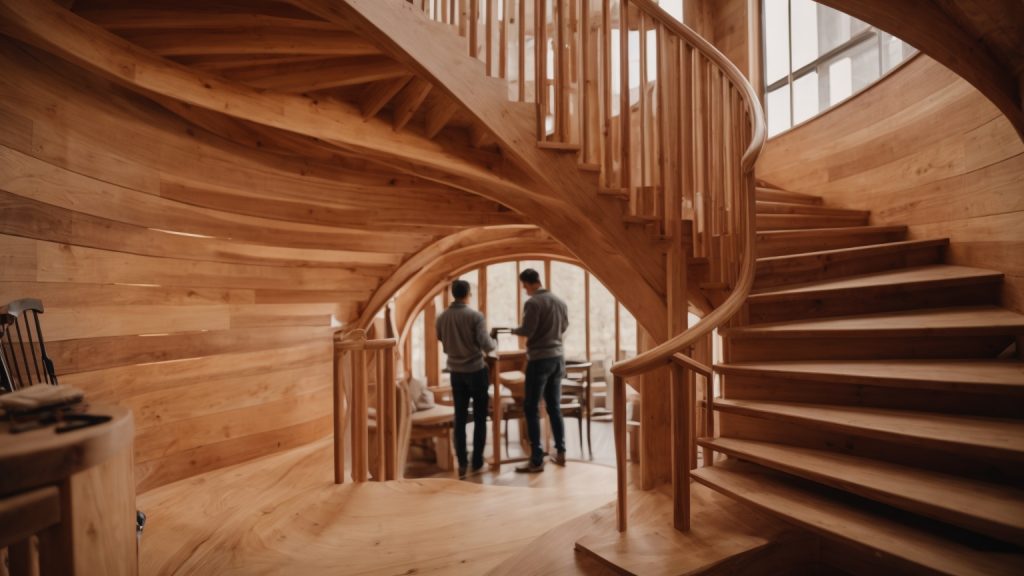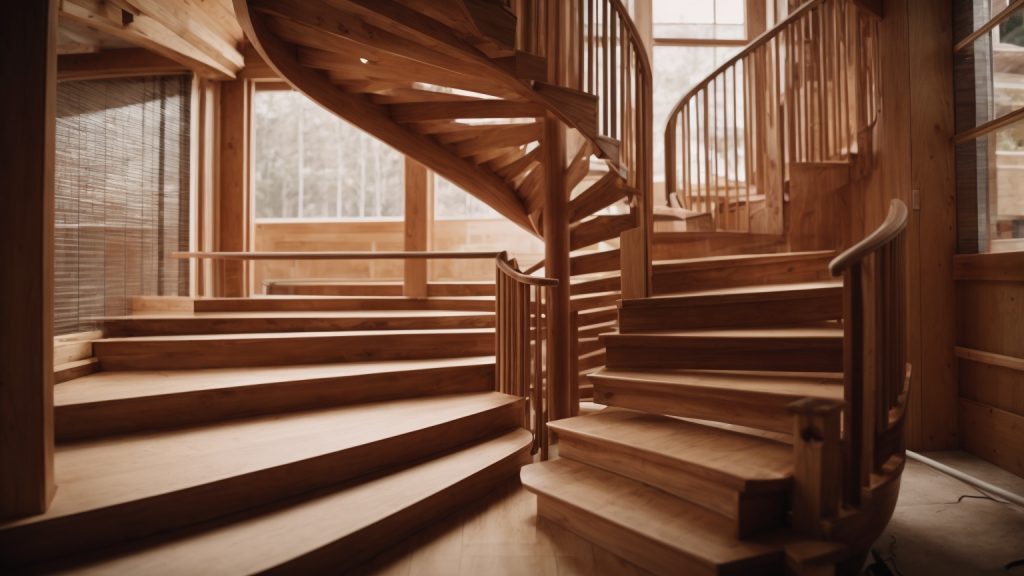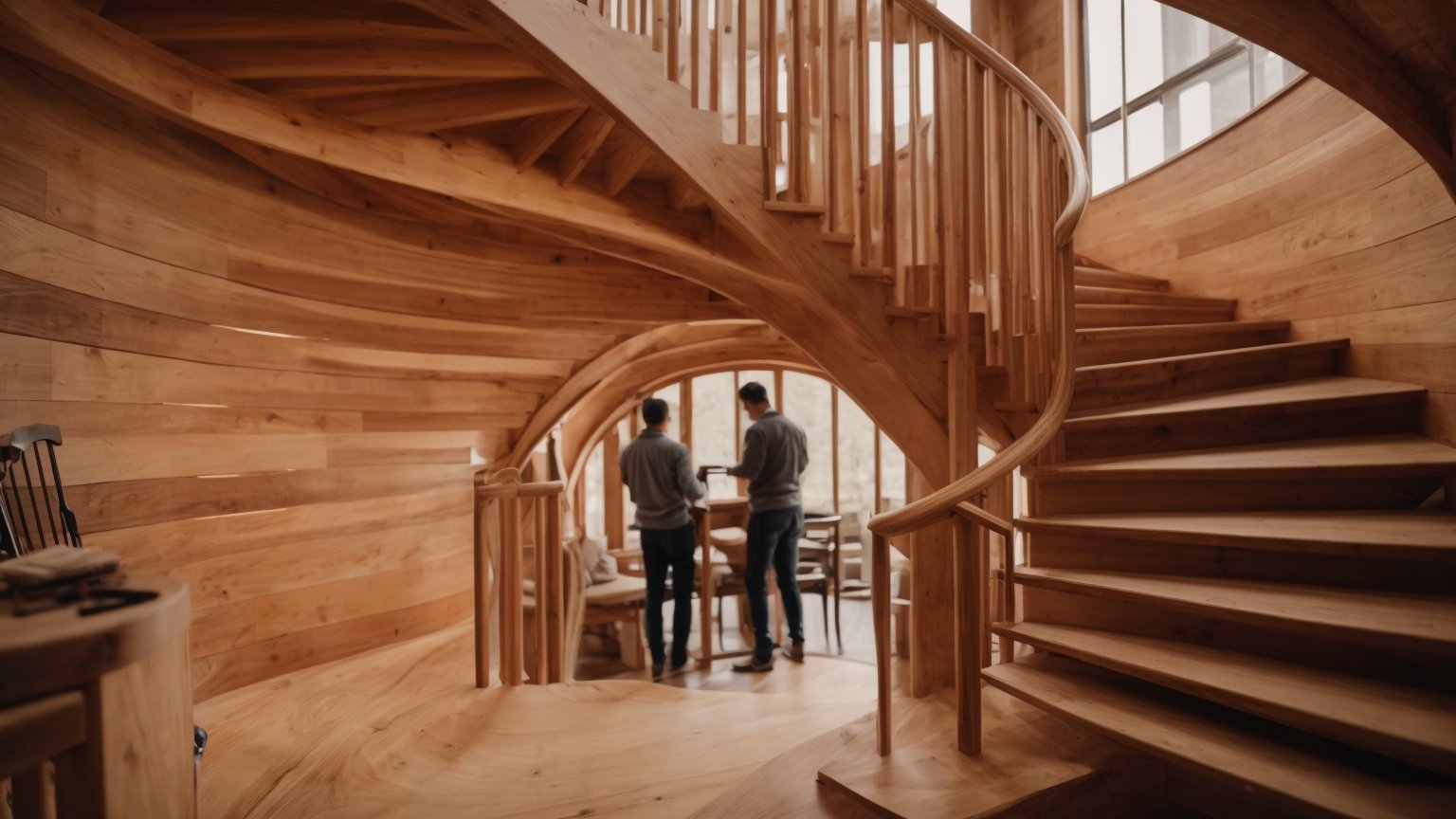If you’re looking to add a unique touch to your home or building, building a wooden spiral staircase might be just the project you’re looking for. Spiral staircases are not only functional, but also add an attractive element to any space. With a little planning and some basic woodworking skills, you can build your own wooden spiral staircase.
The first step in building a wooden spiral staircase is to decide on the location. Spiral staircases tend to work best in tight spaces and parts of the room that don’t receive heavy foot traffic. Once you’ve chosen the location, you’ll need to design the staircase. This involves deciding on the thickness and width of the treads, as well as the steepness of the spiral. Keep in mind that the International Residential Code (IRC) limits the distance from the bottom of one tread to the bottom of the next (the rise) to 9 1/2 inches.
Once you have a design in place, it’s time to start building. Building a wooden spiral staircase can be a challenging project, but with the right tools and materials, it’s definitely doable. In the next few paragraphs, we’ll walk you through the steps involved in building a wooden spiral staircase, from laying out the spiral to installing the treads and handrail. So grab your tools and let’s get started!
Understanding Spiral Staircases

If you’re looking for a stylish and space-saving solution for your home or building, a spiral staircase may be the perfect choice. Spiral staircases are not only visually appealing but also functional, allowing you to save valuable floor space. In this section, we’ll cover the basics of spiral staircases to help you understand what you need to know before you start building.
Design Considerations
Before you start building your spiral staircase, it’s important to consider a few design factors. Here are some things to keep in mind:
- Location: Spiral staircases are ideal for small spaces or areas where a traditional staircase won’t fit. Consider where you want to install your spiral staircase and make sure there is enough room for it.
- Materials: Spiral staircases can be made from a variety of materials, including wood, metal, and glass. Choose a material that fits your style and budget.
- Safety: Safety is a crucial consideration when building a spiral staircase. Make sure your staircase meets local building codes and is structurally sound.
Advantages of Spiral Staircases
Spiral staircases offer several advantages over traditional staircases. Here are a few reasons why you might want to consider a spiral staircase:
- Space-saving: Spiral staircases take up less floor space than traditional staircases, making them ideal for small homes or apartments.
- Visual appeal: Spiral staircases are visually striking and can add a unique design element to any space.
- Versatility: Spiral staircases can be installed in a variety of locations, including outdoor spaces, attics, and lofts.
Disadvantages of Spiral Staircases
While spiral staircases offer many benefits, they also have a few drawbacks. Here are some things to keep in mind:
- Limited accessibility: Spiral staircases can be difficult for some people to use, especially those with mobility issues or disabilities.
- Narrow treads: The treads on spiral staircases are narrower than those on traditional staircases, which can make them more difficult to use.
- Higher cost: Spiral staircases can be more expensive to build than traditional staircases, especially if you choose high-end materials.
Materials Needed
When it comes to building a wooden spiral staircase, you’ll need to gather a variety of materials to ensure its stability and longevity. Here are the main materials you’ll need to get started:
Types of Wood
Choosing the right type of wood is crucial for building a sturdy and beautiful spiral staircase. Some of the best options include:
- Oak: This hardwood is known for its durability and strength, making it a popular choice for staircase construction.
- Maple: Another strong and durable hardwood, maple is often used for its attractive grain patterns.
- Pine: A softwood that is easy to work with, pine is a budget-friendly option for those on a tight budget.
Other types of wood that can be used for spiral staircase construction include cherry, mahogany, and walnut. Be sure to choose a wood that will complement the overall design of your home or building.
Fasteners and Hardware
In addition to the wood itself, you’ll need a variety of fasteners and hardware to ensure that your spiral staircase is secure and stable. Some of the most important items include:
- Screws: These will be used to attach the treads and risers to the center pole.
- Bolts: Bolts are used to secure the center pole to the base plate and the top plate.
- Nuts and washers: These are used in conjunction with bolts to ensure a tight and secure fit.
- Center pole: This is the main support structure of the staircase and should be made of a strong and durable material such as steel or aluminum.
- Base plate and top plate: These plates are used to secure the center pole to the floor and ceiling.
Be sure to choose high-quality fasteners and hardware to ensure that your spiral staircase is safe and secure for years to come.
Designing Your Staircase

Before starting to build your wooden spiral staircase, you need to design it properly to ensure it fits your space and meets your needs. Here are some tips to help you design your staircase.
Determining the Dimensions
The first step in designing your spiral staircase is determining the dimensions. Measure the height from the floor to the ceiling where you want to install your staircase. This measurement will determine the number of steps you need. The standard height for each step is between 7 and 8 inches.
Next, measure the diameter of the space where you want to install your staircase. The diameter will determine the size of the center pole and the treads. The minimum diameter for a spiral staircase is 5 feet.
Once you have determined the height and diameter, you can use a spiral staircase calculator to determine the number of steps, the size of the center pole, and the size of the treads.
Creating a Blueprint
After determining the dimensions, create a blueprint of your staircase. The blueprint should include the height, diameter, number of steps, size of the center pole, and size of the treads. You can use software such as SketchUp or AutoCAD to create a 3D model of your staircase.
When creating your blueprint, consider the placement of your staircase. Spiral staircases work best in tight spaces and parts of the room that don’t receive heavy foot traffic, such as corners. You should also consider the aesthetic of your staircase and choose a design that complements your home’s style.
In conclusion, designing your wooden spiral staircase is an important step in the building process. By determining the dimensions and creating a blueprint, you can ensure that your staircase fits your space and meets your needs.
Building the Staircase
Building a wooden spiral staircase can seem like a daunting task, but with the right tools and materials, you can create a beautiful and functional staircase that will last for years to come. In this section, we will walk you through the steps of building a wooden spiral staircase, including cutting the wood, assembling the stairs, and installing the handrail.
Cutting the Wood
The first step in building your wooden spiral staircase is to cut the wood to the correct size and shape. You will need to cut the center post, the risers, and the treads to the appropriate length and angle. It is important to measure carefully and double-check your measurements before making any cuts.
To cut the wood, you will need a saw, such as a circular saw or a jigsaw, and a straight edge or a template to guide your cuts. You may also want to use a miter saw or a table saw for more precise cuts.
Assembling the Stairs
Once you have cut all of your wood to the correct size and shape, you can begin assembling the stairs. Start by attaching the risers to the center post, using screws or bolts to secure them in place. Then, attach the treads to the risers, making sure they are level and evenly spaced.
As you assemble the stairs, it is important to check for any gaps or unevenness and make adjustments as needed. You may also want to sand or finish the wood to give it a smooth and polished look.
Installing the Handrail
The final step in building your wooden spiral staircase is to install the handrail. The handrail provides safety and support as you climb the stairs and can also add a decorative touch to your staircase.
To install the handrail, you will need to drill holes in the center post and attach the handrail brackets. Then, slide the handrail onto the brackets and secure it in place with screws or bolts.
Overall, building a wooden spiral staircase requires patience, precision, and attention to detail. By following these steps and taking the time to do it right, you can create a beautiful and functional staircase that will enhance the look and feel of your home.
Finishing Touches
Sanding and Finishing
Once you have completed the installation of your wooden spiral staircase, it is important to sand and finish it properly. Sanding the stairs will help to smooth out any rough spots or splinters, and finishing will protect the wood from moisture and other damage.
Start by sanding the stairs with a fine-grit sandpaper, working your way up to a higher grit for a smoother finish. Be sure to sand the treads, risers, and balusters, as well as any other exposed wood surfaces.
Next, apply a finish to the stairs to protect the wood. There are many different types of finishes available, including varnish, stain, and polyurethane. Choose the finish that best suits your needs and apply it according to the manufacturer’s instructions.
Safety Checks
Before using your new spiral staircase, it is important to perform a safety check to ensure that it is secure and stable. Here are a few things to check:
- Check that all screws and bolts are tight and secure.
- Make sure that the handrail is securely attached and at the proper height.
- Check that the treads are level and not loose.
- Ensure that the staircase is properly anchored to the floor and ceiling.
Performing these safety checks will help to ensure that your new wooden spiral staircase is safe and secure for you and your family to use.
